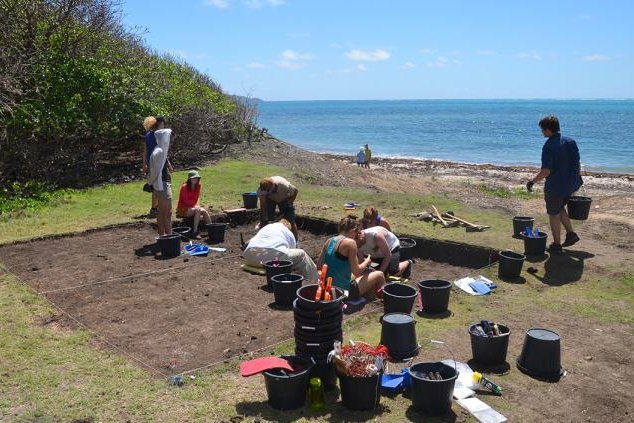Students from the University of Oregon, North Carolina State University and University College London survey an archaeological dig site on Carriacou Island. Photo by Scott Fitzpatrick
Dec. 19 (UPI) -- The earliest migrations from South America to the Caribbean began 5,800 years ago, and according to a new survey of archaeological data on the islands, the seafarers first settled the larger, northernmost islands of the Greater Antilles, what is today Cuba, Hispaniola and Puerto Rico.
Previously, archaeologists surmised the earliest South American settlers in the Caribbean moved onto the smaller, southernmost islands of the Lesser Antilles, slowly making their way north, island by island, over a period of a few thousands years.
When researchers from the University of Oregon analyzed more than 2,500 radiocarbon measurements collected from archaeological sites on 55 Caribbean islands, they revealed a completely different migration pattern.
"This scenario contradicts a competing stepping-stone model that many archaeologists still subscribe to, which asserts a south-to-north settlement beginning in the Lesser Antilles," lead researcher Matthew Napolitano, a doctoral student in the department of anthropology at Oregon, said in a news release.
The new findings, published this week in the journal Science Advances, suggest the first Caribbean settlers traveled hundreds of miles across open seas in single-hulled canoes. The study's authors estimated the settlers were attracted to the more productive lands and bountiful natural resources of the larger, northernmost islands.
Instead of collecting new pieces of evidence and performing new dating tests, scientists subjected previously dated materials to strict criteria to determine which radiocarbon measurements were most reliable. Half of the data points were reliable. Researchers put the remaining data through a series of statistical analyses, resulting in an improved colonization model.
"By carefully applying these criteria, we were able to improve confidence about the reported dates, as well as whether the dated materials actually relate to human activity," said Scott Fitzpatrick, anthropology professor and associate director of the University of Oregon's Museum of Natural and Cultural History. "Our analysis of the resulting acceptable dates, which represent human occupations on 26 islands, provides the first reliable model for initial arrival in the region."















